Publications
Publications in peer reviewed journals
Controls on the relative abundances and rates of nitrifying microorganisms in the ocean
2022 - Biogeosciences, 19: 5401–5418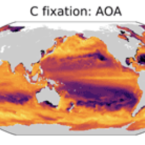
Abstract:
Nitrification controls the oxidation state of bioavailable nitrogen. Distinct clades of chemoautotrophic microorganisms – predominantly ammonia-oxidizing archaea (AOA) and nitrite-oxidizing bacteria (NOB) – regulate the two steps of nitrification in the ocean, but explanations for their observed relative abundances and nitrification rates remain incomplete and their contributions to the global marine carbon cycle via carbon fixation remain unresolved. Using a mechanistic microbial ecosystem model with nitrifying functional types, we derive simple expressions for the controls on AOA and NOB in the deep, oxygenated open ocean. The relative biomass yields, loss rates, and cell quotas of AOA and NOB control their relative abundances, though we do not need to invoke a difference in loss rates to explain the observed relative abundances. The supply of ammonium, not the traits of AOA or NOB, controls the relatively equal ammonia and nitrite oxidation rates at steady state. The relative yields of AOA and NOB alone set their relative bulk carbon fixation rates in the water column. The quantitative relationships are consistent with multiple in situ datasets. In a complex global ecosystem model, nitrification emerges dynamically across diverse ocean environments, and ammonia and nitrite oxidation and their associated carbon fixation rates are decoupled due to physical transport and complex ecological interactions in some environments. Nevertheless, the simple expressions capture global patterns to first order. The model provides a mechanistic upper estimate on global chemoautotrophic carbon fixation of 0.2–0.5 Pg C yr−1, which is on the low end of the wide range of previous estimates. Modeled carbon fixation by AOA (0.2–0.3 Pg C yr−1) exceeds that of NOB (about 0.1 Pg C yr−1) because of the higher biomass yield of AOA. The simple expressions derived here can be used to quantify the biogeochemical impacts of additional metabolic pathways (i.e., mixotrophy) of nitrifying clades and to identify alternative metabolisms fueling carbon fixation in the deep ocean.
Prokaryotic Life in the Deep Ocean's Water Column.
2022 - Ann Rev Mar Sci, in press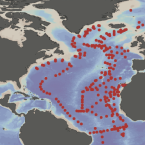
Abstract:
The oceanic waters below a depth of 200 m represent, in terms of volume, the largest habitat of the biosphere, harboring approximately 70% of the prokaryotic biomass in the oceanic water column. These waters are characterized by low temperature, increasing hydrostatic pressure, and decreasing organic matter supply with depth. Recent methodological advances in microbial oceanography have refined our view of the ecology of prokaryotes in the dark ocean. Here, we review the ecology of prokaryotes of the dark ocean, present data on the biomass distribution and heterotrophic and chemolithoautotrophic prokaryotic production in the major oceanic basins, and highlight the phylogenetic and functional diversity of this part of the ocean. We describe the connectivity of surface and deep-water prokaryotes and the molecular adaptations of piezophilic prokaryotes to high hydrostatic pressure. We also highlight knowledge gaps in the ecology of the dark ocean's prokaryotes and their role in the biogeochemical cycles in the largest habitat of the biosphere.
Enhanced nitrogen and carbon removal in natural seawater by electrochemical enrichment in a bioelectrochemical reactor
2022 - J Environ Manage, 323: 116294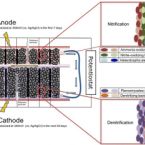
Abstract:
Municipal and industrial wastewater discharges in coastal and marine environments are of major concern due to their high carbon and nitrogen loads and the resulted phenomenon of eutrophication. Bioelectrochemical reactors (BERs) for simultaneous nitrogen and carbon removal have gained attention owing to their cost efficiency and versatility, as well as the possibility of electrochemical enrich specific groups. This study presented a scalable two-chamber BERs using graphite granules as electrode material. BERs were inoculated and operated for 37 days using natural seawater with high concentrations of ammonium and acetate. The BERs demonstrated a maximum current density of 0.9 A m−3 and removal rates of 7.5 mg NH4+-N L−1 d−1 and 99.5 mg L−1 d−1 for total organic carbon (TOC). Removals observed for NH4+-N and TOC were 96.2% and 68.7%, respectively. The results of nutrient removal (i.e., ammonium, nitrate, nitrite and TOC) and microbial characterization (i.e., next-generation sequencing of the 16S rRNA gene and fluorescence in situ hybridization) showed that BERs operated with a poised cathode at −260 mV (vs. Ag/AgCl) significantly enriched nitrifying microorganisms in the anode and denitrifying microorganisms and planctomycetes in the cathode. Interestingly, the electrochemical enrichment did not increase the total number of microorganisms in the formed biofilms but controlled their composition. Thus, this work shows the first successful attempt to electrochemically enrich marine nitrifying and denitrifying microorganisms and presents a technique to accelerate the start-up process of BERs to remove dissolved inorganic nitrogen and total organic carbon from seawater.
Limnospira fusiformis harbors dinitrogenase reductase (nifH)-like genes, but does not show N2 fixation activity
2022 - Algal Research, 66: 102771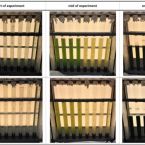
Abstract:
East African soda lakes (EASLs), some of them world-renowned for their large flocks of flamingos, range amongst the most productive aquatic ecosystems worldwide. The non-heterocytous filamentous cyanobacterium Limnospira fusiformis (formerly Arthrospira fusiformis or Spirulina platensis), forming almost unialgal blooms, is supposed to be a key driver in those ecosystems and is gaining increasing attention because of its nutritional value. Compared to phosphorus and carbon availability, these lakes show reduced nitrogen supply. We studied the possibility of molecular nitrogen (N2) fixation in Limnospira, as contradictory statements have been published, and some closely related taxa were confirmed as N2 fixers (diazotrophs). We cultivated nine isolates originating from various EASLs under nitrate-rich and nitrate-depleted conditions. We detected dinitrogenase reductase (nifH)-like genes in all strains; however, the genes grouped within nifH cluster IV that mostly contains nitrogenases not functioning in N2 fixation. Accordingly, incubations with 15N2 gas did not support N2 fixation activity of the investigated strains. Under laboratory conditions, all strains faded during nitrate-depleted growth after approximately three weeks. Both phycocyanin and chlorophyll-a dropped to a threshold, and chlorophyll fluorescence indicated a severe problem with nitrogen supply. In summary, our data indicate that the investigated Limnospira fusiformis strains are not capable of N2 fixation.
A nitrite-oxidising bacterium constitutively consumes atmospheric hydrogen
2022 - ISME J, 16: 2213-2219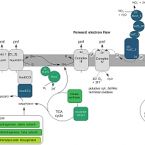
Abstract:
Chemolithoautotrophic nitrite-oxidising bacteria (NOB) of the genus Nitrospira contribute to nitrification in diverse natural environments and engineered systems. Nitrospira are thought to be well-adapted to substrate limitation owing to their high affinity for nitrite and capacity to use alternative energy sources. Here, we demonstrate that the canonical nitrite oxidiser Nitrospira moscoviensis oxidises hydrogen (H2) below atmospheric levels using a high-affinity group 2a nickel-iron hydrogenase [Km(app) = 32 nM]. Atmospheric H2 oxidation occurred under both nitrite-replete and nitrite-deplete conditions, suggesting low-potential electrons derived from H2 oxidation promote nitrite-dependent growth and enable survival during nitrite limitation. Proteomic analyses confirmed the hydrogenase was abundant under both conditions and indicated extensive metabolic changes occur to reduce energy expenditure and growth under nitrite-deplete conditions. Thermodynamic modelling revealed that H2 oxidation theoretically generates higher power yield than nitrite oxidation at low substrate concentrations and significantly contributes to growth at elevated nitrite concentrations. Collectively, this study suggests atmospheric H2 oxidation enhances the growth and survival of NOB amid variability of nitrite supply, extends the phenomenon of atmospheric H2 oxidation to an eighth phylum (Nitrospirota), and reveals unexpected new links between the global hydrogen and nitrogen cycles. Long classified as obligate nitrite oxidisers, our findings suggest H2 may primarily support growth and survival of certain NOB in natural environments.
Nitrogen fixation by diverse diazotrophic communities can support population growth of arboreal ants
2022 - BMC Biology, 20: 135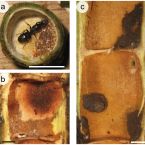
Abstract:
Background: Symbiotic ant-plant associations, in which ants live on plants, feed on plant-provided food, and protect host trees against threats, are ubiquitous across the tropics, with the Azteca-Cecropia associations being amongst the most widespread interactions in the Neotropics. Upon colonization of Cecropia’s hollow internodes, Azteca queens form small patches with plant parenchyma, which are then used as waste piles when the colony grows. Patches—found in many ant-plant mutualisms—are present throughout the colony life cycle and may supplement larval food. Despite their initial nitrogen (N)-poor substrate, patches in Cecropia accommodate fungi, nematodes, and bacteria. In this study, we investigated the atmospheric N2 fixation as an N source in patches of early and established ant colonies. Results: Via 15N2 tracer assays, N2 fixation was frequently detected in all investigated patch types formed by three Azteca ant species. Quantified fixation rates were similar in early and established ant colonies and higher than in various tropical habitats. Based on amplicon sequencing, the identified microbial functional guild—the diazotrophs—harboring and transcribing the dinitrogenase reductase (nifH) gene was highly diverse and heterogeneous across Azteca colonies. The community composition differed between early and established ant colonies and partly between the ant species. Conclusions: Our data show that N2 fixation can result in reasonable amounts of N in ant colonies, which might not only enable bacterial, fungal, and nematode growth in the patch ecosystems but according to our calculations can even support the growth of ant populations. The diverse and heterogeneous diazotrophic community implies a functional redundancy, which could provide the ant-plant-patch system with a higher resilience towards changing environmental conditions. Hence, we propose that N2 fixation represents a previously unknown potential to overcome N limitations in arboreal ant colonies.
Global grassland diazotrophic communities are structured by combined abiotic, biotic, and spatial distance factors but resilient to fertilization
2022 - Front Microbiol, 13: 821030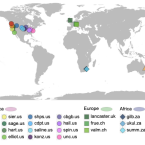
Abstract:
Grassland ecosystems cover around 37% of the ice-free land surface on Earth and have critical socioeconomic importance globally. As in many terrestrial ecosystems, biological dinitrogen (N2) fixation represents an essential natural source of nitrogen (N). The ability to fix atmospheric N2 is limited to diazotrophs, a diverse guild of bacteria and archaea. To elucidate the abiotic (climatic, edaphic), biotic (vegetation), and spatial factors that govern diazotrophic community composition in global grassland soils, amplicon sequencing of the dinitrogenase reductase gene—nifH—was performed on samples from a replicated standardized nutrient [N, phosphorus (P)] addition experiment in 23 grassland sites spanning four continents. Sites harbored distinct and diverse diazotrophic communities, with most of reads assigned to diazotrophic taxa within the Alphaproteobacteria (e.g., Rhizobiales), Cyanobacteria (e.g., Nostocales), and Deltaproteobacteria (e.g., Desulforomonadales) groups. Likely because of the wide range of climatic and edaphic conditions and spatial distance among sampling sites, only a few of the taxa were present at all sites. The best model describing the variation among soil diazotrophic communities at the OTU level combined climate seasonality (temperature in the wettest quarter and precipitation in the warmest quarter) with edaphic (C:N ratio, soil texture) and vegetation factors (various perennial plant covers). Additionally, spatial variables (geographic distance) correlated with diazotrophic community variation, suggesting an interplay of environmental variables and spatial distance. The diazotrophic communities appeared to be resilient to elevated nutrient levels, as 2–4 years of chronic N and P additions had little effect on the community composition. However, it remains to be seen, whether changes in the community composition occur after exposure to long-term, chronic fertilization regimes.
Ammonia-oxidizing archaea possess a wide range of cellular ammonia affinities.
2022 - ISME J, 16: 272-283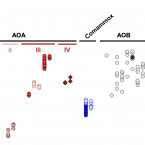
Abstract:
Nitrification, the oxidation of ammonia to nitrate, is an essential process in the biogeochemical nitrogen cycle. The first step of nitrification, ammonia oxidation, is performed by three, often co-occurring guilds of chemolithoautotrophs: ammonia-oxidizing bacteria (AOB), archaea (AOA), and complete ammonia oxidizers (comammox). Substrate kinetics are considered to be a major niche-differentiating factor between these guilds, but few AOA strains have been kinetically characterized. Here, the ammonia oxidation kinetic properties of 12 AOA representing all major cultivated phylogenetic lineages were determined using microrespirometry. Members of the genus Nitrosocosmicus have the lowest affinity for both ammonia and total ammonium of any characterized AOA, and these values are similar to previously determined ammonia and total ammonium affinities of AOB. This contrasts previous assumptions that all AOA possess much higher substrate affinities than their comammox or AOB counterparts. The substrate affinity of ammonia oxidizers correlated with their cell surface area to volume ratios. In addition, kinetic measurements across a range of pH values supports the hypothesis that-like for AOB-ammonia and not ammonium is the substrate for the ammonia monooxygenase enzyme of AOA and comammox. Together, these data will facilitate predictions and interpretation of ammonia oxidizer community structures and provide a robust basis for establishing testable hypotheses on competition between AOB, AOA, and comammox.



